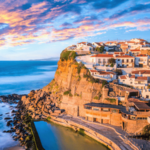Quick Links:
Travel Guides | Travel Gear | Packing Lists | Resources & Tools
Kyoto, the former imperial capital of Japan, is a living museum of Japanese culture and history. The city is home to over 2,000 temples and shrines, including the iconic golden Kinkaku-ji and the bamboo groves of Arashiyama. Visitors can experience traditional tea ceremonies, stay in ryokans, and witness the beauty of cherry blossoms in spring. Kyoto offers a serene counterpoint to Tokyo’s modernity and is ideal for those seeking to immerse themselves in Japanese traditions.
Best Things to Do
Search and Compare flight deals
Deals from your favorite airlines.
Best Hotels in Kyoto
Why to Go:
- Historic Temples and Shrines: Kyoto is home to over 1,600 temples and shrines, many of which are UNESCO World Heritage sites. The Kinkaku-ji (Golden Pavilion) is famous for its stunning gold leaf exterior and serene surrounding gardens. Another must-visit is Fushimi Inari Taisha, known for its thousands of vermilion torii gates that create a picturesque hiking trail up the mountain.
- Traditional Geisha Culture: The Gion district is renowned for its traditional wooden machiya houses and is one of the last remaining geisha districts in Japan. Visitors can experience a traditional tea ceremony or even catch a glimpse of geishas and maikos (apprentice geishas) as they make their way to appointments.
- Beautiful Gardens: Kyoto boasts some of the most exquisite gardens in Japan. The Ryoan-ji rock garden is famous for its minimalist design and tranquil atmosphere, while the Nanzen-ji temple complex features stunning gardens that change with the seasons, showcasing cherry blossoms in spring and vibrant foliage in autumn.
- Culinary Delights: Kyoto is known for its unique cuisine, including kaiseki, a traditional multi-course meal that emphasizes seasonal ingredients and presentation. The city also offers a variety of street food, such as yudofu (tofu hot pot) and matcha (green tea) sweets, making it a culinary paradise.
- Cultural Festivals: Kyoto hosts numerous festivals throughout the year, celebrating its rich cultural heritage. The Gion Matsuri in July is one of Japan’s most famous festivals, featuring elaborate floats and traditional performances. The Aoi Matsuri in May showcases ancient rituals and processions.
- Scenic Views: The city is surrounded by mountains, offering stunning views and hiking opportunities. The Arashiyama Bamboo Grove is a must-see, where visitors can walk through towering bamboo stalks. The nearby Iwatayama Monkey Park provides a chance to see wild monkeys in their natural habitat.
- Historic Districts: Kyoto’s historic districts, such as Higashiyama and Pontocho, are filled with charming streets, traditional shops, and tea houses. Strolling through these areas allows visitors to experience the city’s rich history and culture.
- Museums and Art: Kyoto is home to several museums that showcase its artistic heritage. The Kyoto National Museum features a vast collection of Japanese art and artifacts, while the Kyoto International Manga Museum celebrates the city’s love for manga and anime.
- Accessibility: Kyoto is well-connected by public transportation, making it easy to explore the city and its surrounding areas. The Shinkansen (bullet train) connects Kyoto to major cities like Tokyo and Osaka, making it a convenient stop on any itinerary.
- Warm Hospitality: The people of Kyoto are known for their warm hospitality and adherence to traditional customs. Visitors often feel welcomed and embraced by the local culture, enhancing their overall experience in the city.
On a similar note...
-

8 Airport Safety Tips: How to Keep Your Stuff Safe
-

7 TSA Secrets You Need to Know
-

The 10 Best Airport Tips and Secrets
-

Cappadocia, Turkey Travel Guide
-

Amalfi Coast, Italy Travel Guide
-

Barcelona, Spain Travel Guide
-

Sintra, Portugal Travel Guide
-

Marrakech, Morocco Travel Guide
-

World's Best Places to Visit near me
-

Palm Springs, USA Travel Guide
Kyoto Travel Tips
Best Months to Visit
The best time to visit Kyoto is during the spring (March to May) and autumn (September to November) months. These seasons offer the most pleasant weather and stunning natural scenery. Spring is famous for cherry blossoms, while autumn features vibrant fall foliage. Summer (June to August) can be hot and humid, and winter (December to February) is cold but offers a quieter, less crowded experience.
The Weather on Kyoto
Kyoto experiences four distinct seasons. Spring (March to May) has mild temperatures ranging from 10°C (50°F) to 20°C (68°F) and is renowned for its cherry blossoms. Summer (June to August) can be hot and humid, with temperatures ranging from 22°C (72°F) to 35°C (95°F). Autumn (September to November) is cool and comfortable, with temperatures between 10°C (50°F) and 25°C (77°F), and beautiful fall colors. Winter (December to February) is cold, with temperatures between 0°C (32°F) and 10°C (50°F), and occasional snowfall.
How to Save Money on Kyoto
Travel Off-Peak: Visit during the winter months (December to February) for lower accommodation rates and fewer tourists, except during the New Year period.
Stay in Budget Accommodations: Consider staying in hostels, guesthouses, or budget hotels. Capsule hotels offer a unique and affordable lodging option.
Use Public Transport: Kyoto’s public transportation system is efficient and affordable. Purchase a day pass for unlimited travel on buses and subways.
Eat Locally: Enjoy affordable meals at local eateries, convenience stores, and market stalls. Try bento boxes, ramen, and street food.
Free Attractions: Many of Kyoto’s temples and shrines are free to enter. Enjoy the city’s beautiful gardens, parks, and scenic walking paths.
Download for FREE
Travel Budget Planner & Checklist in Excel
Start using the Ultimate Travel Budget Planner and Checklist in Excel today, and embark on your dream trip without the stress of overspending. Happy Travel!
Download!What to Eat
Kyoto’s cuisine is known for its delicate flavors and seasonal ingredients:
Kaiseki: A traditional multi-course meal that showcases seasonal ingredients and meticulous presentation.
Yudofu: A simple yet delicious dish of tofu simmered in a light broth, often enjoyed at temples and traditional restaurants.
Kyo-ryori: Kyoto-style cuisine, featuring local specialties such as bamboo shoots, hamo (pike conger), and yuba (tofu skin).
Soba and Udon: Enjoy these traditional Japanese noodles served in hot broth or chilled with dipping sauce.
Matcha: Kyoto is famous for its green tea. Try matcha-flavored sweets, such as matcha ice cream, mochi, and cakes.

The FREE Packing Guide for All-Inclusive Trips
Download our fillable and printable packing list + tips + more!
Safety
Kyoto is one of the safest cities in the world, but it’s important to take standard precautions:
Petty Theft: While rare, be mindful of your belongings, especially in crowded areas and public transport.
Traffic: Pay attention to traffic signals and pedestrian crossings. Bicycles are common in Kyoto, so be aware of bike lanes and riders.
Health Precautions: Tap water is safe to drink. Ensure you have travel insurance that covers medical emergencies.
Natural Disasters: Japan is prone to earthquakes. Familiarize yourself with local emergency procedures and evacuation routes.
Getting Around
- Public Transport: Kyoto has an extensive public transportation network, including buses, subways, and trains. Purchase a day pass for unlimited travel.
- Bicycles: Renting a bicycle is a popular and enjoyable way to explore the city. Many rental shops offer affordable rates and maps of cycling routes.
- Walking: Kyoto is a pedestrian-friendly city with many attractions within walking distance of each other. Walking allows you to fully appreciate the city’s beauty.
- Taxis: Taxis are available but can be expensive. Use them for short trips or when public transport is not convenient.
- Rental Cars: Renting a car is not necessary for exploring Kyoto but can be useful for day trips to surrounding areas.
Entry & Exit Requirements
Visa Requirements: Many nationalities, including those from the USA, Canada, EU countries, and Australia, can enter Japan visa-free for short stays (up to 90 days). Check the latest visa requirements based on your nationality.
Passport Validity: Ensure your passport is valid for the duration of your stay in Japan.
Customs Regulations: Familiarize yourself with customs regulations regarding what you can bring into and take out of Japan. Common restrictions include limits on alcohol, tobacco, and certain food items.
Health Requirements: No specific vaccinations are required for entry into Japan, but it’s always a good idea to check the latest health advisories and ensure you have travel insurance that covers medical emergencies.
Final Thoughts
Kyoto, with its rich history, stunning temples, and traditional culture, offers a unique glimpse into Japan’s past and present. Whether you’re strolling through cherry blossom-lined streets, exploring ancient temples, or savoring exquisite cuisine, Kyoto promises an unforgettable experience. By planning your trip wisely and taking advantage of local tips, you can immerse yourself in the magic of this timeless city without breaking the bank.
Recommended for You
Selecting the Best Swimwear for Women: Whether you’re lounging by...
As you embark on exciting journeys around the globe, basking...
Traveling is an adventure, and whether you’re exploring the bustling...
Author

Cotripia is your gateway to elevated travel. We serve as your portal to the world of stylish travel, exquisite beauty products, luggage, and all the vital travel essentials. Furthermore, we provide an array of valuable resources, including expertly crafted packing guides, meticulous checklists, insider tips, enlightening ebooks, and much more.
View all posts








